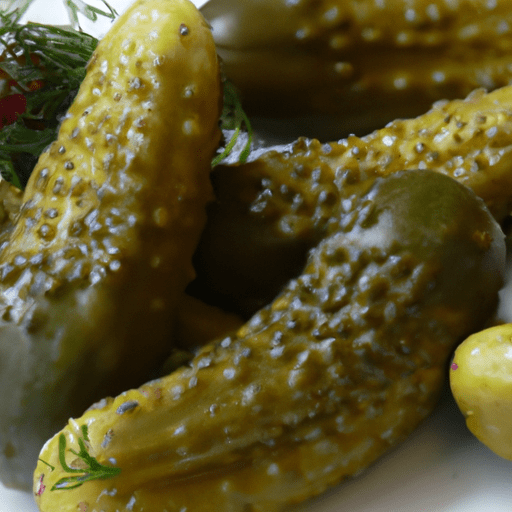Cornichons: A Tangy Delight
Are you a fan of pickles? If so, let me introduce you to the delightful world of cornichons! These small, tart pickles are a staple in French cuisine and have gained popularity around the globe for their unique taste and versatility in cooking. In this post, we’ll explore the wonderful world of cornichons, diving into their taste, common uses in cooking, nutritional value, and some interesting facts. So let’s get started!
Taste
Cornichons are known for their zesty and tangy flavor. These tiny pickles are made from young cucumbers which are picked before they fully mature. Due to their early harvest, cornichons have a crisp texture with a refreshing, sour taste. The combination of vinegar, spices, and herbs used in their pickling brine adds a burst of flavor that complements their natural tartness. The result is a pickle that is both pleasantly sour and satisfyingly crunchy, making it a treat for pickle lovers everywhere.
Common Uses in Cooking
Cornichons have a wide range of uses in cooking, adding a delicious kick to various dishes. In France, they are often enjoyed as a condiment alongside cheese, particularly Camembert and Roquefort. The tangy flavor of cornichons provides a perfect contrast to the creamy richness of the cheese, creating a harmonious balance of flavors.
These delightful pickles also find their way into charcuterie boards, adding a pop of acidity and crunch to cured meats such as salami or prosciutto. The salty and savory combination is simply irresistible. Cornichons can also be diced and added to tartar sauce, sandwiches, or potato salads, giving these dishes an extra zing. Their small size makes them ideal for garnishing appetizers, adding a touch of visual appeal and flavor to canapés and hors d’oeuvres.
Nutritional Value
While cornichons may be small in size, they pack a surprising amount of nutrients. Low in calories and fat, these tasty pickles are a guilt-free addition to any meal. They are also a good source of fiber and contain small amounts of vitamins and minerals such as vitamin K, manganese, and calcium.
However, it is worth noting that cornichons are high in sodium due to the pickling process. So, if you’re watching your sodium intake, it’s advisable to enjoy them in moderation or opt for low-sodium versions.
History and Interesting Facts
Cornichons have a rich history dating back centuries. Originating in the Mediterranean region, the cucumber was first cultivated in ancient times and later embraced by the Romans. The term “cornichon” itself is derived from the French word “corn”, meaning horn, linking to their small and elongated shape.
During the 19th century, cornichons gained popularity in France, particularly in the Burgundy region, where they became a quintessential accompaniment to wine and cheese. Since then, cornichons have spread beyond the borders of France, gaining a global fanbase.
Interestingly, cornichons are often compared to another popular pickle, gherkins. While both are pickled cucumbers, they have distinct differences. Cornichons are generally smaller, more tart, and possess a firmer texture than gherkins. These unique qualities make them stand out in the world of pickles.
Final Thoughts
Cornichons are a delightful addition to any palate, providing a burst of tangy flavor and crunch to various dishes. Whether enjoyed as a condiment, a snack, or a garnish, these small pickles are sure to enhance the overall taste experience. So why not give them a try? You might just fall in love with their unique and zesty charm!
Cornichons
Origin: Cornichons are small, tart pickles that originated in France. The name “cornichon” comes from the French word for gherkin.
Common Uses: Cornichons are commonly used as a garnish or condiment. They are often served with charcuterie, in salads, or as a topping for sandwiches. Cornichons can also be used in recipes to add a tangy flavor to dishes such as potato salad or tartar sauce.
Nutritional Benefits: Cornichons are low in calories and fat. They are a good source of dietary fiber and contain small amounts of vitamins and minerals, including vitamin K, vitamin A, and calcium. However, it’s worth noting that cornichons are pickled in vinegar, so they can be high in sodium.
Unique Properties: Cornichons are typically made from small, firm cucumbers, which are harvested when they are still young and tender. This gives them their characteristic crunchy texture. They are pickled in a brine that is typically flavored with spices such as mustard seeds, dill, and tarragon, which contribute to their tangy and savory taste.
Historical Significance: Cornichons have a long history in French cuisine. They have been enjoyed in France since at least the 17th century, and are often associated with traditional French dishes such as pâté and foie gras. In addition to their culinary uses, cornichons have also been used in traditional medicine for their potential digestive benefits.




Use the share button below if you liked it.
It makes me smile, when I see it.